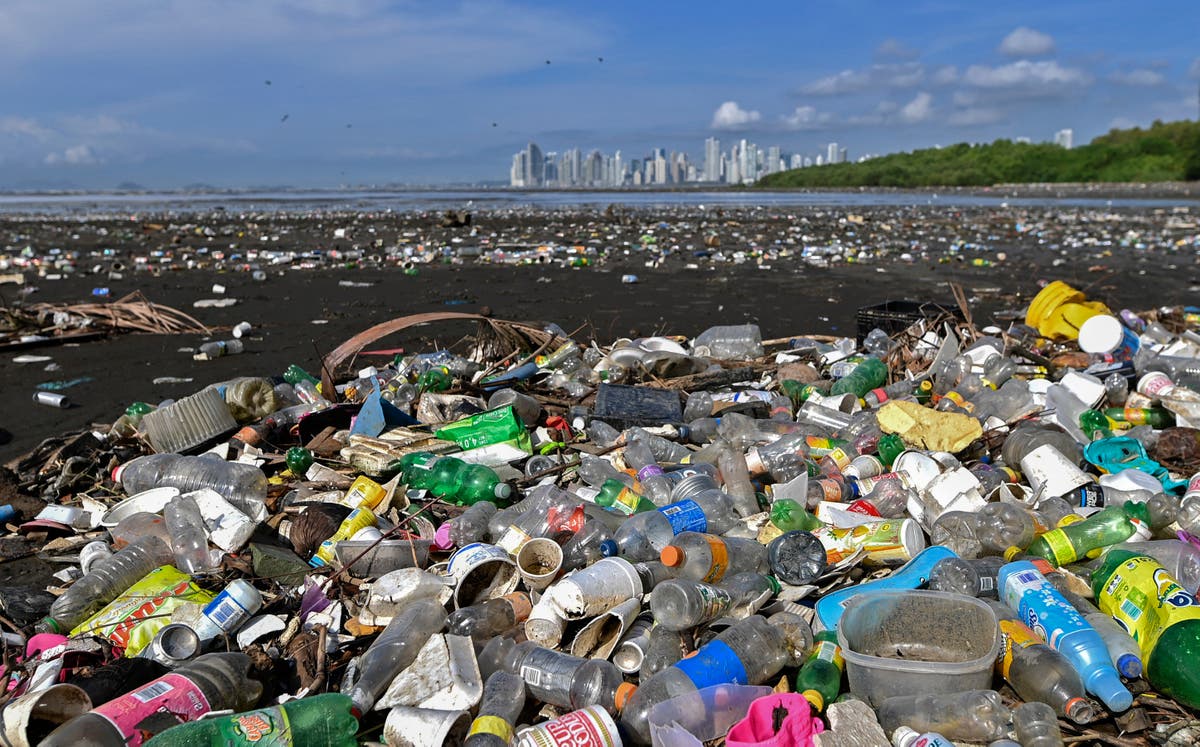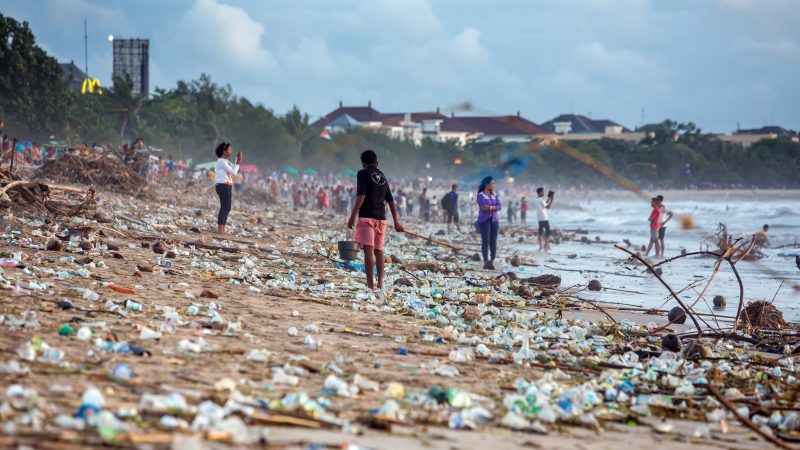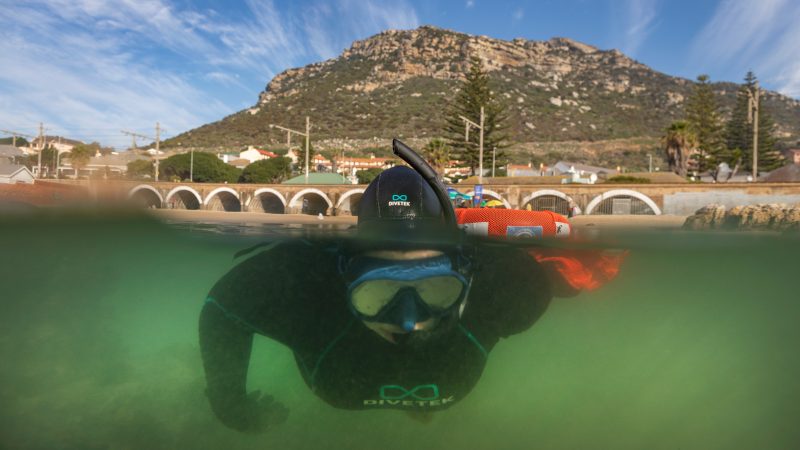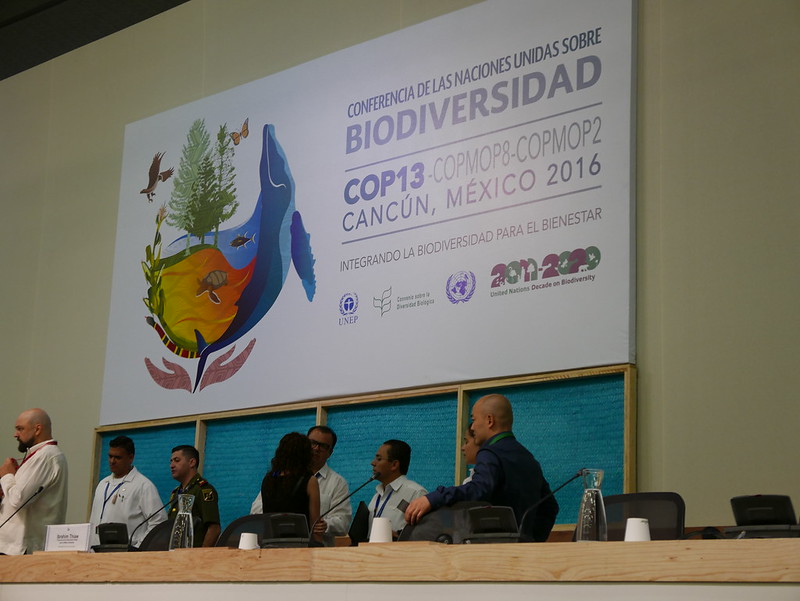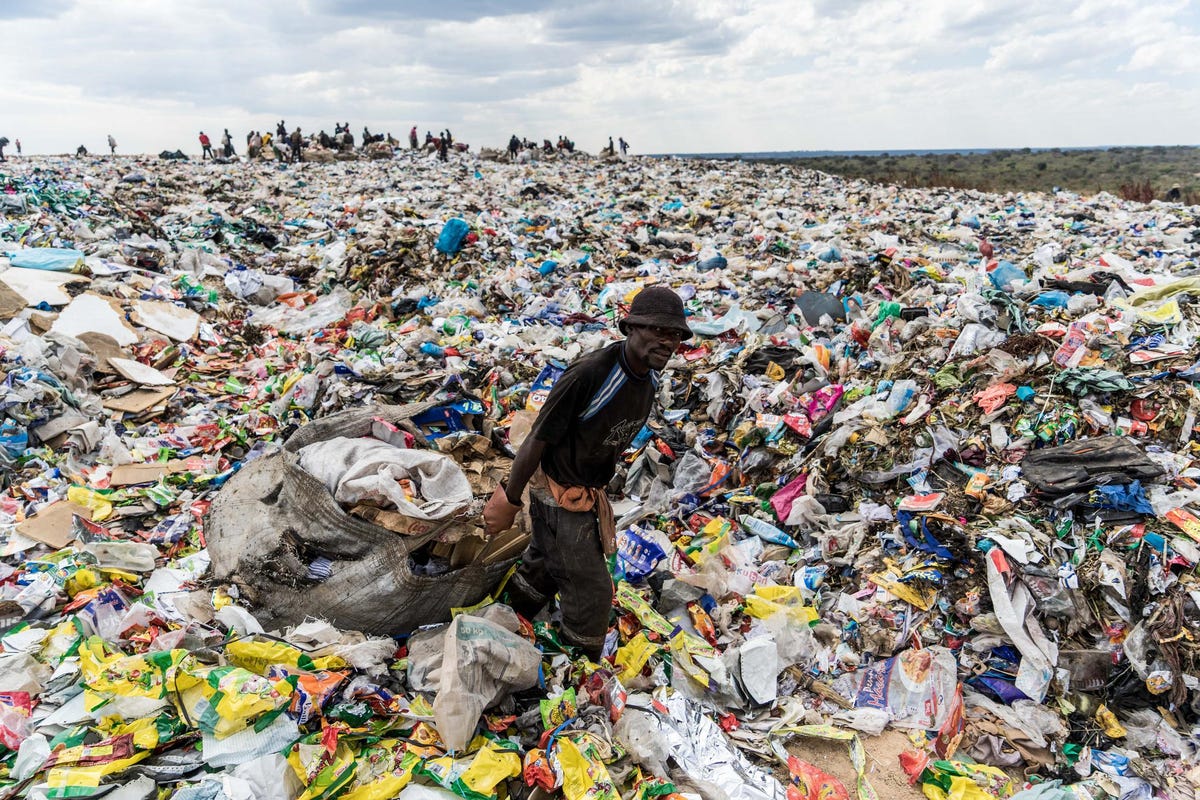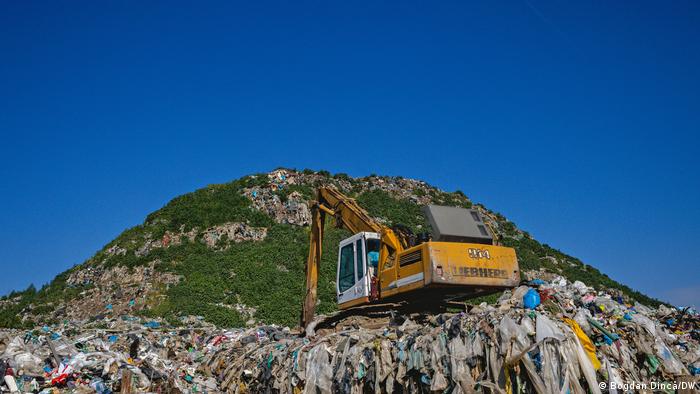HOLLAND, MI — The July sun beat down as Casey Walker weaved among Lake Michigan beachgoers at Holland State Park, picking up litter. In his bag, Walker carried cigarette buts, wrappers, plastic bottles and other typical beach trash — but there was one form of garbage he couldn’t really pick up, even though he and everyone else were surrounded by it.All around, tiny plastic fragments littered the sand.“You’d need to comb the whole beach with a sifter to try to get it all,” said Walker, a salesperson at Great Lakes Wine & Spirits who was volunteering with an Adopt-A-Beach cleanup July 28. “Once I started looking at the ground, I started seeing it everywhere.”Volunteer, Casey Walker of Holland, picks up trash during an Adopt-A-Beach cleanup at Holland State Park in Holland, Michigan on Wednesday, July 28, 2021. (Joel Bissell | MLive.com)Unfortunately, Holland is far from the only Great Lakes town with a beach awash in plastic. Broken down bits of bottle caps, wrappers, beach toys — as well as non-consumer items like pre-manufactured “nurdle” pellets — have become a staple of shorelines; accumulating at popular beaches where people come on holiday, daytrips or just to catch a sunset.But researchers who are tracking plastic pollution in the Great Lakes say the problem goes deeper than beach litter. Humans and animals are ingesting plastic particles released into the environment. Studies are finding microscopic plastic fibers in drinking water, beer, and fish — raising questions about what affect those particles may have on people’s health as well as the health of ecosystems which are absorbing plastic at the base of the food web.Meanwhile, studies show the volume of plastic in the lakes is getting worse. Researchers say various stewardship efforts aren’t making much dent in the flow of plastic of any size into the lakes, where items can travel long distances before sinking to the bottom, washing ashore somewhere or breaking down and being eaten by birds, fish or insects.Five years ago, researchers at the Rochester Institute of Technology (RIT) estimated that 22 million pounds (10,000 metric tons) of plastic debris are entering the Great Lakes annually from the U.S. and Canada. Rather than accumulating in “garbage patches” as plastic tends to do in the oceans, lake currents swirl that debris around, breaking it down and sending Chicago and Milwaukee’s plastic onto beaches in western Michigan, or Detroit and Cleveland’s trash to shorelines in Pennsylvania and New York.Along the way, it can absorb contaminants such as PFAS, DDT or PCBs, turning the smaller, “microplastic” sized pieces less than five millimeters in size into new vectors for toxic chemical exposure once they’re ingested by fish which are, potentially, consumed by humans.The extent of the problem is, unfortunately, far from being clear. Relatively few studies have examined the environmental risks from either “micro” or “macro” plastics in freshwater systems like the Great Lakes compared to the oceans, even though such lakes and river systems tend to be the first waters that industrial or consumer plastic debris reaches.“When people think of plastic pollution, they tend to think of the oceans,” said Sherri Mason, sustainability coordinator at Penn State Behrend who conducted some of the initial studies on microplastic in the Great Lakes as a researcher in New York.“I think it’s because of the visuals that are associated with oceanic plastic pollution. It’s quite impactful. You don’t see the same kind of images when it comes to the Great Lakes,” Mason said. “But nevertheless, if you look upstream from the oceans, you’ll see that most plastic is making its way to the oceans through freshwater systems.”[embedded content]How much plastic is in the Great Lakes?In the decades since synthetic polymer manufacturing advances begat the rise of mass-produced plastic in the 1950s, more than 8 billion metric tons has been made worldwide.The versatile material revolutionized society. But it doesn’t just go away when we’re done with it. Full decomposition takes hundreds of years for even simple, single-use items such as plastic bottles or straws. Some of is incinerated, some of is recycled, but most plastic ends up in landfills. Unfortunately, a lot of it also ends up in oceans, lakes and rivers.In the Great Lakes, the big number is 22 million pounds entering the lakes annually — a 2016 figure that study authors say was developed based on population estimates around each lake and modeling of how much plastic waste certain zip codes produce.Children pick up plastic debris on North Beach in South Haven, MI. (Joel Bissell | MLive.com)Of that, the study concluded that half of the plastic pollution entering the Great Lakes, about 11 million pounds each year, goes into Lake Michigan. The next highest load is to Lake Erie, which gets about 5.5 million pounds. Lake Ontario gets about 3 million pounds. Lake Huron gets about 1.3 million pounds and Lake Superior gets about 70,000 pounds.Over time, natural wear and abrasion, sunlight and ultraviolet radiation break larger pieces down into smaller fragments. Eventually, they become microplastics.“Consistently, once we look at years and years of data, we see that about 85 percent of what our team leaders pick up is made either wholly or partly of plastic,” said Jennifer Caddick, who coordinates the Adopt-A-Beach program at the Alliance for the Great Lakes nonprofit in Chicago. “That’s a data point we’ve been able to extract pretty consistently.”Dealing with the problem is an expensive proposition. According to a 2015 study published in the Journal of Great Lakes Research, the estimated the overall cost of beach cleanups, storm drain devices, street sweeping, waterway cleanup, and public anti-littering campaigns could amount to $400 million each year in the region.But litter doesn’t tell the whole story. “Nurdles,” or resin pellets used to manufacture plastic products, are being found in surprisingly high quantity on beaches in every Great Lakes state. Their presence can’t be blamed on litterbugs because consumers don’t touch them. Nurdles are being lost somewhere in the supply chain and they’re ending up in the lakes.In 2018, Canadian researchers examined 66 beaches on all five lakes. They found nurdle pellets on 42 of them, at an average of 19 pellets per square meter, in a variety of colors.The heaviest concentration was at Baxter Beach on Lake Huron in Sarnia, Ontario. More than 7,200 pellets were found in the sand along the shoreline. High pellet numbers were also found at Bronte Beach in Oakville, Ont. near Toronto, and in Rossport, Ont. on the north shore of Lake Superior where a Canadian Pacific train derailed in 2008 and spilled pellets.There are efforts to crackdown on such pollution. The plastics industry runs a voluntary program called Operation Clean Sweep. Lawmakers announced a bill this spring that would prohibit discharge of nurdle pellets and other pre-production plastic into waterways.A 15-minute survey of plastics on North Beach in South Haven produces a handful of “nurdles,” industrial plastic pellets used for making products. (Joel Bissell | MLive.com)The Plastic Pellet Free Waters Act is among Congressional or state bills aimed at curbing plastic pollution and moving toward a “circular economy” where all or most plastic waste is converted into raw material and new “virgin” plastic creation is reduced or eliminated.To that end, the Break Free From Plastic Pollution Act would tax plastic bags and other containers, as set up a national bottle bill similar to Michigan’s 10-cent deposit program, and require manufacturers to manage single-use plastic container recycling.States are already trying to shift the waste disposal cost burden to manufacturers through “extended producer responsibility” (EPR) laws. Maine and Oregon each passed bills this summer to force producers to manage and recycle more plastic waste. Similar bills are proposed in California, Hawaii, Maryland, Massachusetts and New York.Such efforts are, perhaps unsurprisingly, opposed by industry.The Break Free Act “would be absolutely devastating to manufacturing jobs and America’s overall economy just as we begin to rebound from the effects of COVID-19,” Tony Radoszewski, Plastic Industry Association president, said in March. “This bill is a direct threat to the nearly one million men and women who work in the domestic plastics industry.”Aquatic Ecologist Tim Hoellein presents water samples from the Chicago River that were studied at his environmental research lab at Loyola University Chicago in Chicago, Ill. (Joel Bissell | MLive.com)Tributaries delivering plastic that fish are eatingRyan Baker stood on his friend Herb Theodore’s fishing boat and shook his head at the patch of trash clumped together in the Kalamazoo River log jam a few feet away.Baker, president of the Kalamazoo River Alliance, a local anglers group, had organized a June 5 cleanup a couple months prior in which volunteers pulled more than 3,000 pounds of junk out of the river near downtown Kalamazoo. Then, July rains came and washed more trash from several urban creeks and an upstream homeless encampment into the river.“In this section of river, once you get through downtown, every other logjam is the same story said Baker. “It’s milk bottles, pop bottles, one-gallon propane tanks. It’s a smorgasbord of junk.”Tributaries like the Kalamazoo River transport significant quantities of plastics to the Great Lakes — although the actual amount that makes it to the lakes versus what sinks into river sediments is still being studied. What is clear is that rivers are bringing plastics from various sources to the lakes and, along the way, fish in those rivers are eating them.In 2016 and 2017, Loyola University Chicago biologists sampled 74 fish from the Muskegon and St. Joseph rivers in Michigan and the Milwaukee River in Wisconsin and found that 85 percent had microplastics in their digestive tract, with an average of 13 particles per fish.Birds are eating plastic, too. In 2019, University of Toronto researchers found microplastic in the digestive systems of double-crested cormorant chicks from Lake Ontario, who are suspected to have ingested the particles by eating fish that had consumed plastic.Tim Hoellein, a Loyola ecologist who studies how plastic interacts with aquatic life, said microplastics are reaching waterways directly through wastewater plant discharges — and indirectly through wastewater biosolid sludges containing plastic that are spread on cropland as fertilizer. When it rains, those particles can move from soils into streams.A Loyola University Chicago researcher processes water samples from the Great Lakes with colored dye at an environmental research lab at Loyola in Chicago, Ill. (Joel Bissell | MLive.com)Research has also shown that microplastic fibers can spread through the air, depositing in remote or rural areas that lack concentrated sources. Sooner later, humans are ingesting them. A 2018 study found microplastic fibers in tap water drawn from the Great Lakes, beer brewed with Great Lakes source water, and commercial sea salt brands.“The problem is waste,” said Hoellein. “It’s trash. It’s our waste management systems and our wastewater systems and, ultimately, probably, our consumer culture.”Microplastic enters wastewater when synthetic fabrics like fleece jackets shed fibers in the washing machine — or, when landfill leachate is treated at water reclamation plants. Landfills are harsh conditions for plastic and accelerate breakdown, say researchers.“We suspect a lot of microplastics being emitted from wastewater treatment plants are actually coming from the landfill leachate,” said John Scott, a chemist at the Illinois Sustainability Technology Center (ISTC) who studies microplastics.In that respect, Scott sees parallels with another significant global emerging contaminant problem: the toxic ‘forever chemicals’ known as PFAS, which persist in the environment and are endemic in wastewater discharges as well as other Great Lakes ecosystems.Unlike PFAS, microplastics aren’t generating the same level of concern from regulators or policymakers, in large part because their impact on humans is less clear.“I honestly thought microplastics was going to be the emerging pollutant we in the wastewater busines were going to worry about, and then PFAS came along,” said Scott Schoolcraft, director of the North Kent Sewer Authority wastewater plant near Grand Rapids. “I suspect at some point it will become an issue. We’re all trying to fry other fish right now.”Swimmers and beachgoers fill South Beach in South Haven, MI. on July 28 2021. (Joel Bissell | MLive.com)State regulators in Michigan are of similar mind.“PFAS is much scarier to the average citizen than microplastics,” said Rich Hobrla, head of the Great Lakes Management Unit in the water resources division at the Michigan Department of Environment, Great Lakes and Energy (EGLE). “In general, people tend to respond more fiercely if they think something very directly affects their health. If there was some tie that suggested people who consume fish that ingest microplastics are more or highly susceptible to cancer, that’s the kind of thing that would really elevate the problem.”Hobrla said EGLE relies on federal agencies for guidance on microplastics and sees its role as limited mostly to encouraging further research.“It’s an important problem, but EGLE has to prioritize,” said Hobrla. “We have lots of important problems and they can’t all be at the top of the list. Unfortunately, this is one that’s not.”61Plastic pollution in the Great Lakes
Category Archives: News
Social cost of plastic made in 2019 is more than India’s GDP, says WWF report
Plastic made in 2019 will cost the environment and society about $3.7 trillion – or more than the gross domestic product (GDP) of India – over its estimated lifetime, according to a new report by wildlife charity WWF.This life span includes the production, consumption and clean up of plastic, said the report that was published on Monday.Plastic production has almost doubled over the past two decades and the global approach to addressing the plastic crisis is failing, it added.The report warned that if these current trends continue, the social cost of the material produced in 2040 may escalate to $7.1 trillion, equivalent to approximately 85 per cent of global spending on health in 2018 and more than the combined GDP of Germany, Canada and Australia in 2019.“The failure of governments to better understand the real costs of plastic has led to poor management of this material, and growing ecological, social, and economic costs for countries,” the report noted.Communities across the world are “unknowingly subsidising” plastic, paying only for its primary production, but failing to account for the full cost imposed by the plastic life cycle, highlighted the report.“In 2019, the cost was just over $1,000 per tonne. However, this price fails to account for the full cost imposed across the plastic lifecycle,” it said.The full cost cited by the report includes greenhouse gas (GHG) emissions in the production process, health impacts, and the waste management of plastic.The WWF cited studies as saying the cost of GHG emissions from across the material’s lifecycle amounted to more than $171 billion, with the management of plastic waste from 2019 alone costing more than $32 billion.Marine pollution from plastic made in 2019 alone “will incur a cost of $3.1 trillion,” the report said.“Plastic takes hundreds to thousands of years to fully degrade and as it degrades, it breaks down into smaller and smaller particles making it hard to recover and remove plastic from the environment. Plastic will therefore remain in the environment to incur further costs,” it added.While several organisations have proposed circular economy approaches to keep plastic within the economy and out of the environment, the report said rising financial and technical resources needed to overhaul societies prevent governments from acting.“These approaches can effectively reduce the negative impacts of plastic, including reducing the annual volume of plastic entering oceans by 80 per cent and GHG emissions by 25 per cent,” it noted, adding that there is a lack of incentive to implement the kinds of systemic changes required.The WWF called for civil society, companies and financial institutions to set up a new global treaty on marine plastic pollution.“A global treaty could provide a well-designed framework encompassing global coordination on definitions, policies, reporting, and implementation support to accelerate the transition to a circular economy for plastic,” it said.“For a new treaty to be established, governments will have to start negotiations through the adoption of a formal negotiation mandate at the 5th session of the UN Environment Assembly in February 2022,” it added.
Social cost of plastic pollution more than GDP of India
The pollution, emissions and clean-up costs of plastic produced in 2019 alone could be $3.7 trillion, according to a report released Monday (6 September) by wildlife charity WWF, warning of the environmental and economic burden of this “seemingly cheap” material.
There is increasing international alarm over the sheer volumes of fossil-fuel based plastics entering the environment, as microplastics have infiltrated even the most remote and otherwise pristine regions of the planet.
In its report, WWF said societies were “unknowingly subsiding” plastic, with their estimates for the lifetime costs of 2019 production equivalent to more than the gross domestic product of India.
“Plastic appears to be a relatively cheap material when looking at the market price primary plastic producers pay for virgin plastic,” said the report ‘Plastics: The cost to society, environment and the economy‘, produced for WWF by the consultancy Dalberg.
“However, this price fails to account for the full cost imposed across the plastic life cycle.”
It estimated that unless there was concerted international action, a projected doubling of plastic production could see costs rocket by 2040 to $7.1 trillion.
The analysis looked at factors including the greenhouse gas emissions in the production process, health impacts, waste management and estimates of the reduction in the economic “services” of ecosystems on land and in water.
Since the 1950s, roughly 8.3 billion tonnes of plastic have been produced with around 60% of that tossed into landfills or into the natural environment.
Tiny fragments have been discovered inside fish in the deepest recesses of the ocean and peppering Arctic sea ice.
The debris is estimated to cause the deaths of more than a million seabirds and over 100,000 marine mammals each year.
“Tragically, the plastic pollution crisis is showing no signs of slowing down, but the commitment to tackle it has reached an unprecedented level,” said Marco Lambertini, Director General of WWF International, in a statement.
‘More plastic than fish’
The report comes as the International Union for the Conservation of Nature (IUCN) meets in the French port city of Marseille, with one motion under consideration calling for an end to plastic pollution by 2030.
Earlier in September the European Union threw its weight behind calls for a legally-binding international agreement to reduce plastic pollution, during UN-hosted talks in Geneva.
The UN Environment Programme has said the planet is “drowning in plastic pollution”, with about 300 million tonnes of plastic waste produced every year.
The proposed resolution is due to be discussed during the United Nations Environment Assembly in Nairobi next year.
France’s minister in charge of biodiversity, Berangere Abba, said if the world failed to act there would be “more plastic in the oceans than fish” by 2050.
Countries eye UN deal to rein in plastic pollution
The European Union on Thursday (2 September) backed calls for a legally binding international agreement to reduce plastic pollution, during a UN-hosted conference in Geneva.
A German official said some 75 nations were already supporting a draft resolution circulated at the meeting, but warned that it could be years before an agreement is put in place.
France’s minister in charge of biodiversity Bérangere Abba said if the world failed to act there would be “more plastic in the oceans than fish” by 2050.
The UN Environment Programme, which is hosting the conference, has said the planet is “drowning in plastic pollution”, with about 300 million tonnes of plastic waste produced every year.
Since the 1950s, roughly 8.3 billion tonnes of plastic have been produced with around 60% of that tossed on landfills or into the natural environment.
Millions of tonnes ends up in our oceans, with the debris causing the deaths of more than a million seabirds and over 100,000 marine mammals each year.
‘Difficult to predict’
More than 1,000 representatives from 140 countries and numerous NGOs participated in the Geneva meeting.
The draft text, presented Thursday by Peru and Rwanda with the support of the European Union, its member states and seven other countries, called for the creation of an intergovernmental negotiating committee to draft an agreement.
The text singles out the importance of microplastics — the tiny fragments that have been detected in every ocean and even at the bottom of the world’s deepest trench.
The aim should be “promoting a circular economy and addressing the full life-cycle of plastics from production, consumption and design to waste prevention, management and treatment”, the draft text said.
The proposed resolution is due to be discussed during the United Nations Environment Assembly in Nairobi next year.
The declaration already has firm support from 25 countries and provisional commitment from 50 more, German environment official Jochen Flasbarth told a press conference.
“Twenty-five plus 50 before we have even started is pretty good,” he said.
“It’s very difficult to predict how long the negotiations will take. I think it will not be in months but rather in a few years to see a convention come into force.”
4 major environmental treaties the U.S. never ratified — but should
In one of his first acts in the White House, President Joe Biden signed an executive order to have the United States rejoin the Paris climate agreement. It signaled an important step in the country recommitting to action to tackle climate change after the Trump administration withdrew the United States from the accord and worked to roll back environmental regulations nationwide.
Biden’s move was hailed by world leaders and applauded by environmentalists at home. But the climate convention wasn’t the only global environmental agreement from which the country has been conspicuously absent.
Here are four international treaties that have been ratified by most of the world’s countries, but not the United States.
1. United Nations Convention on the Law of the Sea
The 1982 Law of the Sea helped set an international framework for managing and protecting the ocean, including by delineating exclusive economic zones and creating the International Seabed Authority, which is currently tasked with drafting regulations for deep seabed mining.
“Originally the U.S. government was on board with the treaty when it was being finalized in the late 1970s, but when President Reagan came into office he called for a review of the negotiations, fired the State Department’s head of negotiations and appointed his own people who created a new list of demands,” says Kristina Gjerde, an adjunct professor at the Middlebury Institute of International Studies and a senior high seas advisor to the International Union for the Conservation of Nature’s Global Marine and Polar Program.
When the treaty wasn’t reworked to meet those needs, Reagan’s team didn’t sign it. It would take until 1994 to get a U.S. signature, but the country still has yet to ratify it. To do so, would require a two-thirds approval in the Senate.
“The Law of the Sea has been uniformly supported by everything from the U.S. Navy to the Department of Commerce,” says Gjerde. “There’s nobody who’s really against it — other than those who don’t like the U.S. to be engaged in multilateral institutions.”
Unfortunately there are enough people in the Senate with that mindset to hold up this treaty, and many others. But that hasn’t stopped people from continuing to push for the United States to accede to the Law of the Sea.
There are numerous reasons why it would be beneficial for the country, but Gjerde says one of the most important right now is that the United States has to take a back seat while regulations are being drafted on deep seabed mining.
“The United States doesn’t have a voice in helping to make sure that the regulations are appropriately environmentally precautionary,” she says. “And the country has a lot of islands and waters that would be subject to potential environmental impacts from seabed mining by other states.”
2. The Convention on Biological Diversity
The treaty, which garnered its first signatures at the 1992 Rio Earth Summit, has been called the world’s best weapon in fighting the extinction crisis. It has three main stated objectives: the conservation of biological diversity, the sustainable use of its components, and the equitable sharing of benefits that arise from using genetic resources.
The United States was a big player in drafting the agreement, but when 150 nations stepped up to sign it, George W. Bush declined to do so. Bill Clinton signed the treaty after he took office in 1993, but it never received the necessary ratification vote by the Senate.
And it still hasn’t.
The United States is the only member of the United Nations that has yet to ratify it, “which is just a disgrace,” says Maria Ivanova, a professor of global governance and director of the Center for Governance and Sustainability at the University of Massachusetts Boston.
This omission stands in stark contrast to the country’s history of commitment to conservation, she says.
“The Convention on International Trade in Endangered Species was initially called the Washington Convention because the first meeting was in D.C.” says Ivanova. “The United States was a champion for that convention and the first to start national parks.”
But that commitment began to fade in the 1980s with “run-amok capitalism,” she says. “That means you can use nature with impunity without replenishing anything. “
The United States does still participate in the Conference of Parties that assemble for the Convention on Biological Diversity, but without having ratified the agreement, it’s relegated to “observer” status. This year it will get some extra muscle from a California delegation that will also be attending in the hope of ramping up the United States’ commitment to biological diversity.
Conference of Parties for the Convention on Biological Diversity in 2016. Photo: Biodiversity International, (CC BY-NC-ND 2.0)
3. Stockholm Convention on Persistent Organic Pollutants
The Stockholm Convention, an effort to protect the health of people and the environment from harmful chemicals, was adopted in 2001. The treaty identifies “persistent” chemicals — those that stay in the environment for a long time and can bioaccumulate up the food chain.
Currently the treaty regulates nearly 30 of these chemicals, which can mean that countries must restrict or ban their use, limit their trade, or develop strategies to properly dispose of stockpiles or sites contaminated by the waste from the chemicals.
So far 184 countries have ratified the agreement. The United States signed it in 2001, but once again, the treaty has yet to be ratified by the Senate. That means that the United States is often behind the curve on banning harmful chemicals, such as the highly toxic pesticide pentachlorophenol.
4. Basel Convention on the Control of Transboundary Movements of Hazardous Wastes and Their Disposal
The United States has also signed but not ratified the Basel Convention, which took effect in 1992. This international treaty limits the movement of hazardous waste (excluding radioactive materials) between countries. It was written to help curb the practice of richer, industrialized nations dumping their hazardous waste into less developed and less wealthy countries.
The convention is now taking on the global scourge of plastic waste, of which the United States is the largest contributor. A new provision went into effect this year that seeks to curb the amount of waste shipped to other countries that can’t be recycled and ends up instead being burned or escaping into the environment.
The Basel Convention has also worked to address electronic waste. The failure of the United States to ratify the treaty, experts say, has allowed companies to shift recycling of toxic computer components to developing countries. Outsourcing of plastic and e-waste recycling from the U.S. to developing countries has recently been linked to chemicals entering the food chain through eggs eaten by the world’s poorest people.
A pile of plastic casing for LCD screens near Sriracha, Thailand. Photo: Basel Action Network, (CC BY-ND 2.0)
Next Steps
If you’re seeing a pattern here of the United States signing — but not ratifying — treaties, you’re not wrong. “In the United States, the biggest hurdle is that ratification of a treaty has to go through the Senate,” says Ivanova.
Despite this roadblock, which has stopped the United States’ full participation in some international agreements for decades, some still hope for a different outcome. “I think it’s sort of the dream of most who are engaged in international action that the United States would join these important international processes,” says Gjerde.
When it comes to the Law of the Sea in particular, she says, “It’s an opportunity to show real, global leadership again in tackling the many challenges facing the ocean.”
There are others who might not agree.
“You hear the argument from a lot of the policymakers internationally that they’ve been doing fine without the United States in the negotiations,” says Ivanova. “So maybe it’s better that the United States doesn’t sign.”
That may be because the United States can object to a lot of things and be an obstacle as negotiations are worked out. Or because the country can negotiate from its own national interest point of view.
“The United States has disproportionate power in global governance,” she says. “Or it used to. It has to regain the credibility and the legitimacy that it lost.”
But, she says, there are likely more benefits to the United States ratifying the conventions and being a rightful actor on the world stage.
“All of these problems are global, and we need all countries engaged,” she says. “We need all hands on deck. And the United States is a powerful state and brings with it a lot of additional expertise and engagement.”
The United States, in addition to government representation, has top universities and NGOs that do research and advocacy. “And so when the United States is a part of an agreement, it brings with it all of the power that it has intellectually and financially,” says Ivanova.
Not participating leaves the country open to criticism, as well as reduces the likelihood some countries will improve their laws on their own. Most recently, the United States’ environmental shortcomings have been called out by China whenever its own record is questioned.
With this in mind, the best thing the United States can do to reestablish its environmental credibility internationally is to take action at home. The Obama administration got the narrative right, but it didn’t sufficiently match on action, Ivanova says. Now, it’s crucial to do better.
“A lot of people misunderstand the global part [of these international treaties],” she says. “You actually implement them at home — you don’t go and implement them in other states. To achieve those goals, you actually have to take action at home.”
Amid the plastic waste crisis, a New scientific discovery offers hope
A team of Chinese scientists has converted a common type of plastic into useful materials using an inexpensive process, raising hopes that the method could be used to turn plastic waste into valuable products at a large scale.
Only 9% of plastic waste ever created has been recycled, in part because the current cost of recycling plastics outweighs any financial return. As a result, it is estimated that one garbage truck’s-worth of plastic enters the world’s oceans every minute.
But, using a catalyst made from common metals, researchers at Tsinghua University in Beijing have converted samples of PET plastic (full name polyethylene terephthalate) into commercially useful chemicals, along with hydrogen which can be used for fuel.
In a paper published in Nature Communications, the team revealed the method can yield commodities worth $3,000 from one ton of waste PET. That compares very favorably to a current market value for recycled PET of about $350-400 per ton.
By developing an economically viable process for dealing with the material, the research appears a promising solution in the fight against plastic waste.
“Our team was excited when we finally obtained the pure and crystalline commodities from PET plastic,” Haohong Duan, a professor of chemistry at Tsinghua University in Beijing, told me. “This result demonstrates the feasibility of transforming waste into valuable products. This achievement encourages us to further optimize this technology and explore new reaction routes to expand the variety of valuable products.”
“In my view, our process can contribute to reducing the burden of waste plastic,” he said.
PET is the most abundant polyester plastic, with some 70 million tons manufactured each year. It is commonly used to make such items as plastic bottles, which a recent study found make up 12% of all plastic trash found within ocean environments.
About 300 million tons of plastic trash are produced annually, of which at least 8.8 million tons end up in the ocean. Waste plastics cause multiple harms to humans, plants and animals, some of which are not yet understood.
The new process breaks PET plastic down into three useful substances: the first, called potassium diformate, or KDF, has commercial uses as a safe replacement for antibiotics as a growth promoter in animal feed; next, the process yields terephthalic acid, or PTA, which is used to make coatings and resins for metal components; lastly, the process yields a small amount of hydrogen, which can be used as a fuel.
Duan explained that cost was the major hurdle preventing the more widespread adoption of existing forms of recycling, upcycling and separation of plastics. But the cost effectiveness of the new process was likely to become more attractive as it is refined. And as energy grids decarbonize and electricity prices drop, such processes should become cheaper still.
Plastic waste washes up on a beach in Koh Samui, Thailand. Environmental groups say tackling the … [+] plastic crisis will require a coordinated, global effort.
AFP via Getty Images
“Generally, the costs of process and revenues of products are the main obstacles determining the industrial feasibility of this technology,” Duan told me. “The former mainly depends on the cost of input chemicals, facility cost, and electricity price, in which the cost of feed stock is relatively stable. The facility cost can be reduced by improving the efficiency of the catalyst and optimizing of the reactor. From an electricity cost perspective, renewable prices continue to plummet. This cost decrease in renewable electricity provides an optimistic and aggressive goal for electrocatalytic technologies.”
Duan and colleagues therefore view waste PET as a valuable resource.
Yet PET is just one of seven main categories of plastic, and even if such a process sees widespread industrial implementation, tackling the mountainous plastic crisis will require a multi-pronged approach. It is contingent upon nations to produce less plastic in the first place, but environmental and legal groups warn that fossil fuel companies, faced with falling demand for their products as energy sources, are gearing up for a shift towards producing massively more plastic.
For this reason, multiple nations and firms have called for the introduction of a new plastic pollution treaty, to curb both the production and use of plastics. Yet major plastic-producing states such as the U.S. have resisted calls to support such an agreement, likely a result of intense lobbying from the oil and gas sector.
Queensland's ban on single-use plastics begins
Queensland businesses are now banned from selling or supplying some plastic and polystyrene products, as the state vows to tackle plastic pollution.Key points:Businesses will be unable to sell or supply several items like plastic straws and cutleryThe government hopes it will reduce pollution by 20 per cent over the next two yearsDisability advocates are asking businesses to be mindful of exemptionsFrom today, the supply of single-use products including straws, cutlery, plates, bowls, stirrers and polystyrene takeaway containers and cups is banned.It is the first phase in what the Environment Minister calls the state’s “war on waste”.”[It’s about] trying to reduce the amount of single-use plastics that end up in our oceans each year,” Meaghan Scanlon said.The Australian Marine Conservation Society (AMCS) has called the move a win for turtles, but disability advocates are encouraging businesses to be open-minded about exemptions.’People are ready for this’Under the policy, businesses can be fined up to $6,000 for non-compliance but will be given a month’s grace period to abide by the new rules.Ms Scanlon said the government was going for an education-first response but believed businesses were on track.
First ever study finds microplastics in northeast Lapland
A research project, led by non-profit organisation Snowchange Cooperative, has found large amounts of microplastics in Näätämöjoki river and Lake Inari. The project’s aim was to track the impacts of climate change in Näätämö, Vuonnijavr, Voronye and Ponoi waters, and they conducted first ever surveys on microplastics in northeast Lapland. The research has shown that the amount of microplastics in Lake Inari is similar to samples taken from lakes in Southern Finland.
Adjunct Professor Tero Mustonen and the research team took samples from Näätämö River basin from Sevettijärvi to Vainosjokii, and the western parts of lake Inari. The highest quantities of microplastics were found in Lake Inari, as well as the Vainosjoki basin in Näätämö. “The results from Lake Inari showed that there is as much microplastics there as in some lakes in Southern Finland,” Mustonen says. The team found six different polymers in their samples, which corresponds to findings in Southern Finland. “From this survey it looks like the microplastics originate from plastic bags, ropes and fibers, so the particles come from consumer products,” he explains.
One of the most distressing aspects is that the samples were collected from wilderness areas that were not close to any cottages, habitation or tourism industries.
While the findings are concerning, Mustonen does not see that there is any immediate threat to anyone’s health. Since microplastics are already everywhere, from toothpaste to bottled water, the concern should be global. Nevertheless, the accumulation of microplastics should be prevented in the North.
Great lake Inari. Photo: Saara-Maria Salonen
Mustonen says that there is a lot that can be done to slow down the accumulation of microplastics; “some concrete first steps are that every time people walk in nature, they should pick up all of the plastic that they find,” he says. Mustonen has already started discussion with the municipal manager of Inari and the Finnish Forest Administration about the findings. “I encouraged them to increase microplastic monitoring and environmental health care,” he says. ADVERTISEMENT
Mustonen also brings up issues with fishing – the samples show that fishing lines, ghost nets (fishing nets that have been abandoned or lost in the waters) are all ground down over time and the particles stay in the water. Eventually the ground down plastic particles will make their way into the local fish population. Part of the problem is also reindeer husbandry. The practise of feeding reindeer on ice in the winter is most likely a part of the problem, since the fodder and feed is often packed in plastic bags. Mustonen says that reindeer husbandry must be supported, but all the plastic should be taken with when leaving the ice.
This is the first time that a research of this size has been conducted in northeast Finland and the Sámi area. The project, funded by Nordic Environmental Finance Corporation (NEFCO), is expanding their research and findings late this fall. There are still more findings to release from this extensive study, but the team wanted to release their findings on microplastics as quickly as possible.
Research team in Näätämö River – from left, Skolt Sámi researcher Jouni Moshnikoff, Snow Change researcher Lauri Hämäläinen, Skolt Sámi co-researcher Juha Feodoroff, researchers Emilia Uurarasjärvi and Tuomi Soininen. Photo: Tero Mustonen
Mustonen explains that the team will measure the amount of plastics coming from the Arctic Ocean to Näätämöjoki, in order to find out how much of the microplastics are created in Näätämöjoki itself. They will also study sediment samples taken from the bottom of the river, in order to investigate the timeline and find out when the microplastics first started to emerge.
The project was conducted with close cooperation with local indigenous peoples and has Skolt Sámi community members as experts and co-researchers. Mustonen wants to thank all the Skolt Sámi people who have helped the research team and is pleased that the project has been done with good cooperation between the team and local Sámi communities. “I would say this is the first time that Sámi knowledge and science has been brought to the dialogue on how the situation awareness is created,” he says.
The project did not concentrate only on microplastics, but also water quality and effects of warming waters to wildlife and fish population in rivers and lakes in Finland and Russia. Due to limitations because of the Covid-19 situation, the team was not able to measure microplastics on the Russian side.
Roma fight environmental racism in Romania
Roma communities driven from Romania’s booming city of Cluj-Napoca say the authorities treat them like human garbage.
Beside the airport on the outskirts of Cluj-Napoca, one of Romania’s fastest growing cities, lies an enormous landfill site. As you fly in, it’s easy to miss the multicolored roofs scattered between rolling green turf and mounds of waste. But at ground level, the area is teeming with life. Horse-drawn carts cross paths with empty garbage trucks returning to the city. Barefoot children run between makeshift wooden houses and crows circle overhead. This is Pata Rât, the country’s biggest landfill and long one of its most glaring environmental sins. For decades, pollution leached from untreated waste and garbage fires blazed, occasionally killing the occupants of those wooden shacks. Under pressure from the EU, the city began work on closing the site in 2015. Some 2.5 million tons of waste, accumulated over 70 years and covering an area the size of 27 football pitches were turfed over, and at the end of 2019, the local authorities declared Pata Rât “history.” Yet for the 1,500 Roma people still living here, Pata Rât is very much alive. And so is the environmental hazard on their doorstep. Two “temporary storage” landfills set up beside the old one in 2015 are still growing steadily, and experts say the old waste was never properly dealt with. “This was not an ecological landfill, it was not built in line with European standards,” Nodis says. “All these toxic substances went into the soil, into the groundwater. Everything in the area is polluted.” ‘Temporary’ landfills next to the original Pata Rât dump have been steadily growing for the last five years and more Driven from the city The Roma residents of Pata Rât began to arrive in the late 1960s and early 1970s. Some were driven by poverty to move to the landfill and work as waste pickers, but most have come in successive waves of evictions since Cluj-Napoca began to see a real estate boom in the 2000s. The last was in 2010, when local authorities evicted 350 inhabitants from Coastei Street near the city center. Linda Greta Zsiga remembers the cold December morning when she and her family were woken by police, city officials and bulldozers at their door. Just two days before, they and 75 other Roma families living on the street had been given notice of their eviction. Their new home was to be a complex of small, modular units nestled between the between Pata Rât’s existing camps. Linda Greta Zsiga says the Romanian authorities have treated her community like garbage Zsiga says the Roma community on Coastei Street was well integrated. They had been there for generations, they paid rent and utilities on their publicly owned homes, and their children attended local schools and kindergartens. Yet suddenly they were being dumped on the city’s trash heap. “They considered us garbage, not humans,” Zsiga says, “and they thought we deserve to live there.” Europe’s largest ethnic minority exposed to environmental hazards Responding to a survey last year, seven out of 10 Romanians said they don’t trust the Roma. Between 20% and 30% said Roma people have too many rights, that the state should be allowed to use violence against Roma, or that discrimination and hate speech against the Roma should not be punished. Such attitudes are not unique to Romania. Across Europe, racism against the continent’s largest ethnic minority results in denial of basic civil rights, exclusion from employment and public services, and — perhaps most strikingly — the marginalization of Roma communities to areas that lack adequate water, sanitation and waste management. Often, these sites are also in hazardous locations. A study published last year by the European Environmental Bureau (EEB) on “environmental racism against Roma communities in Central and Eastern Europe,” found that the Roma were “disproportionately exposed to environmental degradation and pollution stemming from waste dumps and landfills, contaminated sites, or dirty industries.” Cramped, dirty and cut off Arriving at Pata Rât, Zsiga found her extended family — 12 people altogether — crammed into a 16-square-meter room. Space was so cramped, they had to keep most of their belongings outside. They shared a single toilet and cold-water shower with the inhabitants of three other similarly overcrowded rooms. Zsiga remembers gazing out of her window across a sea of garbage. “There were no doves, no trees,” she says. “I love nature.” A 2012 report by the UN Development Programme found that 22% of adults there suffered from chronic disease or some form of disability. Researchers documented high incidence of skin infections, asthma, bronchitis, high blood pressure, heart and stomach problems, and a report European Roma Rights Centre found that over two years following their eviction, reported health problems more than doubled among the Coastei community. The oldest camp at Pata Rât is called ‘Dallas’ after the US soap opera. Driven by poverty, Roma began arriving here in the late 1960s to live off the landfill as waste pickers The EEB study describes one of the major factors in environmental racism against the Roma as forced eviction from “places with high economic value.” The Coastei community wasn’t given a reason for their eviction. But Zsiga has no doubt why they were moved. “They wanted to ‘clean’ Cluj of Roma,” she says. “Now very few Roma still live in the city.” The municipality of Cluj-Napoca told DW that they are cleaning up Pata Rât and providing health and other services to the community. They also stated that they are trying to prevent evictions and are partners in a program providing housing for 30 families, although they are not providing funding to the scheme. Waste-pickers put out of business There isn’t any solid health data from Pata Rât since the landfill was covered over, but an NGO worker in the area said respiratory diseases remain common, including among children. And economically, the closure of the dump has made life in Pata Rât even harder. Adela Ludvig, a 28-year-old mother of four, has lived beside the landfill for as long as she can remember. Her home is built from plywood, the roof an old canvas advertising banner — scrap materials collected from the dump. These days, her “villa” as Ludvig calls it, has a view onto a chemical waste dump covered in blue plastic foil and protected by barbed wire. Adela Ludvig and her children outside the home she built from scrap materials found on the landfill Ludvig used to collect plastic bottles and foil, cans and cardboard. She says a local recycling company paid the equivalent of €0.12 ($0.14) for a kilo of plastic, meaning she could make €40 in a day. “I could buy food,” she says, “or medicine, when the children needed it.” But the new “temporary” dumps are fenced off. When the landfill closed, waste pickers like Ludvig were left without work. “People were crying with hunger,” she says. Ludvig and her children — she has a fifth on the way — now live on the €220 she gets in child benefits each month. The nearest source of water is several hundred meters away and she has to visit it four or five times a day to meet her family’s needs. They have access to a power generator but cannot afford to pay for gasoline. Pata Rât communities fight back A year after the landfill was declared “history,” the major of Cluj-Napoca promised that the Pata Rât camps would “disappear by 2030” — without giving any indication of what is to happen to the 350 families living there. But well before his announcement, residents had been taking matters into their own hands. In 2012, Zsiga and others from Coastei camp set up an association that’s working with other NGOs to campaign for housing solutions for Pata Rât, and suing the authorities over the evictions. They are currently awaiting a decision on their case from the European Court of Human Rights. The grassy meadows of Pata Rât might look picturesque, but environmental scientists warn that the site is still contaminated by untreated waste And thanks to an initiative supported by Norway Grants (by which the Norwegian government funds social projects in southern and eastern Europe) 35 families from Coastei were moved to Cluj-Napoca or nearby villages between 2014 and 2017. Zsiga, her partner and children, now live in a three-room apartment in the city. But she hasn’t turned her back on Pata Rât. Her siblings and their families still live there and she’s working at the site to support another 30 families who will move in a second stage of the initiative. “I wish that no one is left in Pata Rât,” Zsiga says, “no one deserves to live there.”
Plastic pollution kills Pacific sea species
SUVA: From endangered freshwater dolphins drowned by discarded fishing nets to elephants scavenging through rubbish, migratory species are among the most vulnerable to plastic pollution, a United Nations report on the Asia-Pacific region said on Tuesday, calling for greater action to cut waste.Plastic particles have infiltrated even the most remote and seemingly pristine regions of the planet with tiny fragments discovered inside fish in the deepest recesses of the ocean and peppering Arctic sea ice.The paper by the UN’s Convention on the Conservation of Migratory Species of Wild Animals focused on the impacts of plastic on freshwater species in rivers and on land animals and birds, which researchers said were often overlooked victims of humanity’s expanding trash crisis.


